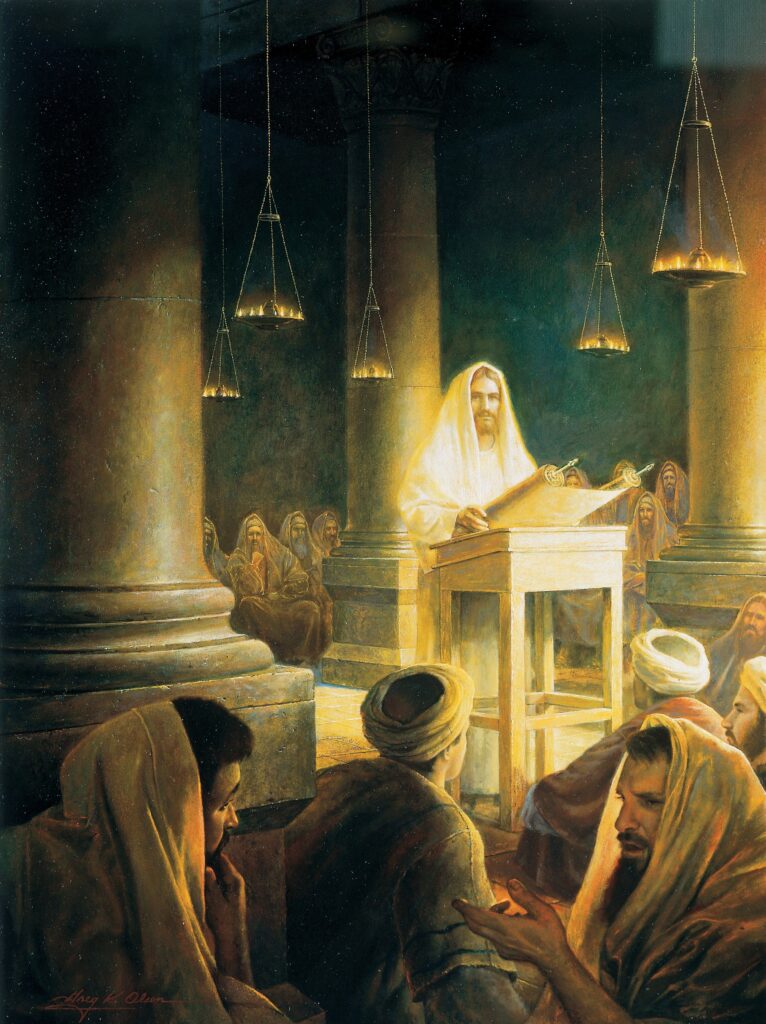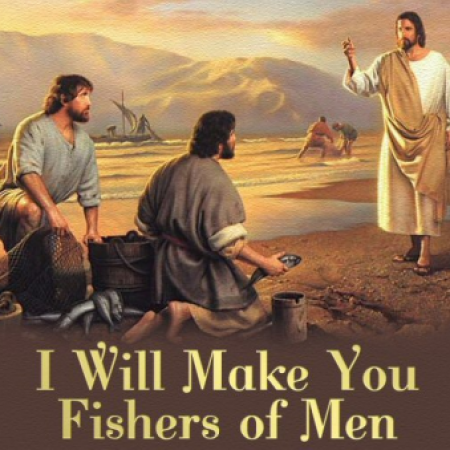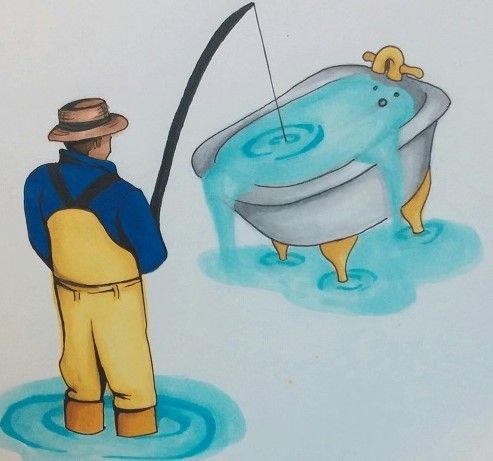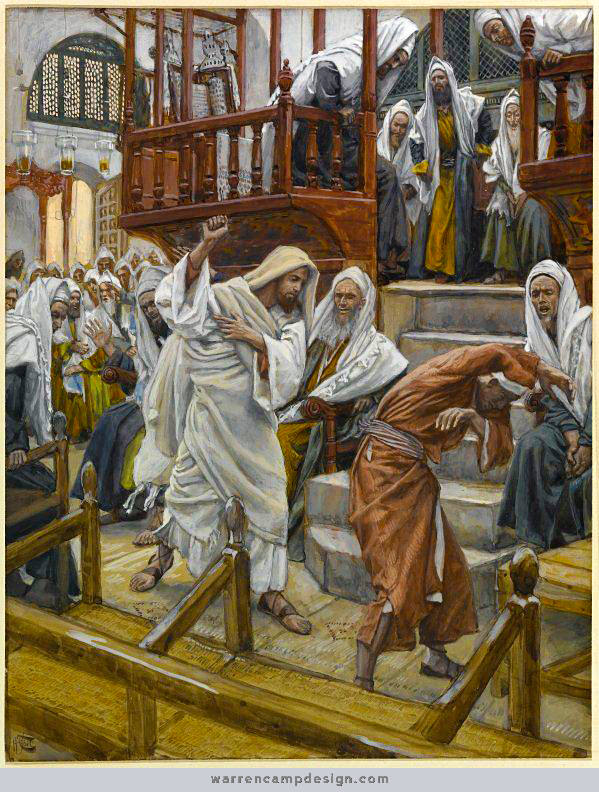To accompany your Come Follow Me study for January 30-February 5
In addition to reading the indicated chapters, you may wish to:
- Read the applicable portions of the New Testament Institute Student Manual at
- https://www.churchofjesuschrist.org/study/manual/new-testament-student-manual/introduction-to-matthew/chapter-2?lang=eng
- https://www.churchofjesuschrist.org/study/manual/new-testament-student-manual/introduction-to-the-gospel-according-to-st-luke/chapter-16-luke-4-8?lang=eng
- See the video Come Follow Me (Jan 30-Feb 5) Matthew 4, Luke 4-5 | Missile Defense System at Come Follow Me (Jan 30-Feb 5) Matthew 4, Luke 4-5 | Missile Defense System – YouTube
- See the video The Temptations of Jesus at https://www.youtube.com/watch?v=s-0KcwwDdk4&t=307s
- See the video Jesus Declares He Is the Messiah at https://www.youtube.com/watch?v=h9M2mprzCF8
- Watch Follow Me, and I Will Make You Fishers of Men at https://www.youtube.com/watch?v=T7xNnBHM5Wg
- Watch The Gospel According to Matthew, minutes 19:21-26:39, at https://www.youtube.com/watch?v=woAhReBytBk&t=6494s
- Watch The Gospel of Luke, minutes 40:46-59:38, at https://www.youtube.com/watch?v=2PHPLApTt7Y
If you would like a Kahoot game related to this material which you could use for personal study or use with your family or your class, click here: https://create.kahoot.it/share/matthew-4-and-luke-4-5/59db40bf-2035-4062-a5d7-cbeefc1ec92d. (To use it with a group, after clicking on this link, you will need to log into Kahoot, creating a free account if you have not done so previously, then click on the blue “Start” button.)
Points to Ponder in Matthew 4 and Luke 4-5
1. After watching the video, The Temptations of Jesus, how did you feel about it? Do you think the producer a Latter-day Saint or not? If you think he is not, how do you account for his use of significant portions of the Latter-day Saint Bible Videos, and why is there some distinctively Latter-day Saint doctrine included? If you think he is a member, how do you account for his failure to include corrections Joseph Smith made in the Joseph Smith Translation, and why would he use pictures showing Satan looking so strange?
2. What significant changes did Joseph Smith make to the account of Jesus’ temptations, and why?
3. How would you summarize the main lessons to be learned from the account of the temptations of Jesus?

4. Why were the people in the synagogue of Nazareth so incensed by Jesus reading a scripture to them that they wanted to kill Him?

5. What are the modern day manifestations of the Savior’s observation that “no prophet is accepted in his own country”? (Luke 4:24)
6. What would impel Peter, Andrew, James, and John to immediately leave their fishing business and follow someone who suddenly appeared on the scene and told them “Follow me”? Would God expect you to follow anyone who appeared on your doorstep with a similar message? What is the difference?

7. How many parallels can you draw between fishing and missionary work?

8. Why, when a man in Capernaum said to Jesus, “I know thee who thou art; the Holy One of God,” did Jesus rebuke him and tell him to be quiet?
9. What else in this week’s reading did you find impressive enough to mark? Why?
Possible Answers to Points to Ponder in Matthew 4 and Luke 4-5
1. After watching the video The Temptations of Jesus, how did you feel about it? Do you think the producer a Latter-day Saint or not? If you think he is not, how do you account for his use of significant portions of the Latter-day Saint Bible Videos, and why is there some distinctively Latter-day Saint doctrine included? If you think he is a member, how do you account for his failure to include corrections Joseph Smith made in the Joseph Smith Translation, and why would he use pictures showing Satan looking so strange?
At https://www.youtube.com/c/messagesofChrist/about, we read: “Hi, my name is Daniel Smith and I love learning about the life of Christ! My hope is to help transport you into the teachings of the Savior through historical, cultural, and visual storytelling. I’ll do this using artwork, 3D recreations, archeology, and more. I’ll focus on the life and teachings of Christ, the events of Holy Week, and the context of the Jewish Feasts and ancient temple worship. I started the channel in 2009 after having had the chance to live in Jerusalem for two months. This was a life-changing experience and I desired to share some of the things I learned. I am a member of the Church of Jesus Christ of Latter-day Saints, though I work to appeal to all faiths. My hope is to help others hear, come, and know Christ through these messages.” I think overall, Brother Smith has done a great job with his video. His omission of references to the JST was probably intentional, so that the video would be more appealing to people of all faiths and that viewers would not be put off but what they might consider “Mormon doctrine.” And without producing original artwork, there are very few pictures of Jesus and Satan together that don’t have Satan with wings or otherwise looking weird. I would hope Latter-day Saint viewers could overlook these less significant details and appreciate the larger lessons to be learned from the account of the temptations of Jesus.
2. What significant changes did Joseph Smith make to the account of Jesus’ temptations, and why?
They include:
- Clarifying that Jesus didn’t go into the wilderness with the intention of looking for temptation, but to “be with God.”
- Clarifying that it was the Spirit, not Satan, who took Jesus to the top of the pinnacle of the temple and to the top of an exceedingly high mountain. Satan just took advantage of His location in each case to further tempt Him. Satan has no power to move the Son of God around against His will, nor to make any of us do anything else that we don’t want to do, unless we yield ourselves into his power through transgression.
3. How would you summarize the main lessons to be learned from the account of the temptations of Jesus?
They could include:
- It is often easiest to get close to God in solitude.
- Temptation comes to everyone, but it is up to us whether or not we will give in to it.
- There really is a devil, who hates us and wants to destroy us.
- Temptation may come most strongly when we are weakest.
- Temptations will usually fall into the same categories as those the Savior experienced: to satisfy our physical desires, to gain fame, or to gain power and wealth.
- With our own will power and divine assistance, we can resist all temptations which may come to us.
- Familiarity with the scriptures can be a great help in warding off temptations.
- Once we have successfully resisted temptation, it is likely that the devil will leave us for a season, as he did Jesus.
4. Why were the people in the synagogue of Nazareth so incensed by Jesus reading a scripture to them that they wanted to kill Him?
It wasn’t just any scripture. It was Isaiah 61:1-2, which was universally understood to refer to the future Messiah. When Jesus finished by saying, “This day is this scripture fulfilled in your ears,” He was telling them that He was the Messiah. Since this was His hometown, and people there had known Him for thirty years as one of them, they couldn’t bring themselves to accept that their neighbor could be the Son of God.
5. What are the modern day manifestations of the Savior’s observation that “no prophet is accepted in his own country”? (Luke 4:24)
For example:
- Some who have known a current prophet or apostle since well before he was called as a general authority may have trouble recognizing him for more than just an old friend.
- Some find it easier to believe in a Joseph Smith or Moses than in someone who lives today.
- Others may find it hard to recognize the divine calling of a bishop whom they once taught in Primary or chased down the hall when he was an Aaronic Priesthood holder.

6. What would impel Peter, Andrew, James, and John to immediately leave their fishing business and follow someone who suddenly appeared on the scene and told them “Follow me”? Would God expect you to follow anyone who appeared on your doorstep with a similar message? What is the difference?
To blindly follow just anyone who showed up claiming to be a prophet or the Messiah would be a mark of gullibility, not faith. But, as 2 Nephi 33:1 assures us, “when a man speaketh by the power of the Holy Ghost the power of the Holy Ghost carrieth it unto the hearts of the children of men.” Surely the Spirit was present when Jesus invited these men to follow Him. Feeling that, they knew what they were doing.
7. How many parallels can you draw between fishing and missionary work?

- Fish are usually afraid of fishermen but not of other fish. Regular members can be much less intimidating in inviting their friends to come to a Church activity or read the Book of Mormon than two young strangers at the door would be.

- You have to bait the hook (with something they like). You may not like to eat worms, but fish do. “Eternal salvation” may sound more vague and less appealing to a non-member friend than the idea of having families forever, or just having a happier family here and now.

- You may have to be patient. If you have a big fish on a thin line, you have to reel him in slowly, letting him go in the other direction for a while until he tires out. Insisting that a friend make a decision immediately whether or not to join the Church could have much the same effect as trying to jerk a big fish out of the water with a thin line.

- You have to go where the fish are. If we never get outside our little group of Church friends, we may not be of much use as the “light of the world” or as “fishers of men.”

- It can be a thrill to catch a fish, and it’s a great joy to help a friend into the Church.

8. Why, when a man in Capernaum said to Jesus, “I know thee who thou art; the Holy One of God,” did Jesus rebuke him and tell him to be quiet?
This man was possessed of “an unclean devil.” On the one hand, thanking the man for his testimony would be a little like a candidate for the presidency of the US being grateful for the endorsement of Vladimir Putin! On the other hand, if viewed as a true sign of Jesus’ identity, this was not how Jesus chose for people to get their testimonies, but through righteous living and the reception of the Holy Ghost. For similar reasons, Jesus told the cleansed leper in Luke 5:13-14 to “tell no man.” The healing was for the benefit of the leper, not to impress or “convert” others.

9. What else in this week’s reading did you find impressive enough to mark? Why?
Your choice. My list includes:
- JST Matt. 4:11-12: I’m impressed that Jesus didn’t require the ministry of angels for Himself, as Matthew 4:11 would suggest (though one did in fact strengthen Him in the Garden of Gethsemane), but that Jesus on this occasion, learning of John the Baptist’s imprisonment, sent angels to minister to John.
- Matthew 4:16: The Savior here identifies Isaiah 9:2 as a Messianic prophecy.
- Matthew 4:22: James and John didn’t procrastinate but “immediately” left all to follow Jesus.
- Matthew 4:23-24: Jesus showed His love by healing all manner of sickness among the people. We’ll talk more about this in another Come Follow Me episode.
- Luke 4:30: Jesus miraculously passed “through the midst” of those who intended to throw Him over a cliff.
- Luke 4:32: Jesus’ “word was with power.”
- Luke 4:38-39: Peter was clearly married. There is no suggestion in the New Testament that Church leaders in general need to be single men.
- Luke 5:5: Peter shows his faith by following Jesus’ instruction, even though he had every reason to think it wouldn’t do any good.
- Luke 5:16: There were times that Jesus, rather than be with the “great multitudes,” preferred to withdraw “into the wilderness” and pray.
- Other incidents in Luke 5 will be discussed later, when we encounter them again in other Gospel accounts.
